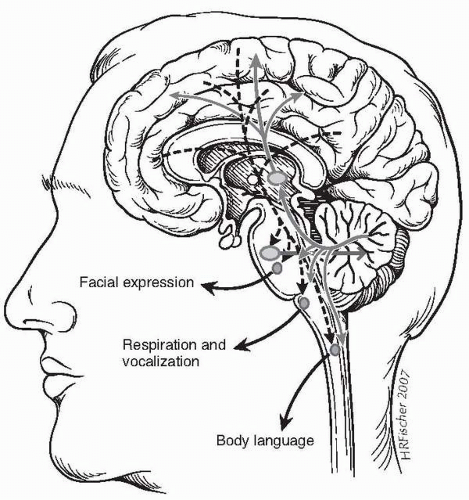Pathological Laughter and Crying
Josef Parvizi
▪ INTRODUCTION
Most psychiatrists are familiar with disorders of emotional experience such as the prototypical mood disorders, including major depressive or bipolar disorders. Psychiatrists are also aware of disorders in which patients suffer from labile emotions that fluctuate rapidly from one extreme to another, such as in borderline personality disorder. However, many are unfamiliar with the problem of inappropriate emotional expression, a condition in which the patient has uncontrollable bouts of laughter or crying or both without an underlying mood or personality disorder. An affected individual exhibits episodes of laughter and/or crying without an apparent motivating stimulus or in response to stimuli that would not have elicited such an emotional response before the onset of their underlying neurological disorder.
▪ ETIOLOGY
The problem in this condition is not an excessive emotional response resulting from labile feelings or a pervasive problem of mood. The problem is a pathologically lowered threshold for the expression of laughter or crying or both. The threshold is so low that the response can be pathologically exaggerated or inappropriate for the context in which it occurs. Patients with this problem have proper knowledge about the cognitive and social norms of the moment, and they are aware that their emotional response is out of proportion to their feeling. The problem is that they appear unable to adjust the type and extent of the emotional display to the contextual information due to lesions along the network connecting cortical and subcortical structures (Fig 11.1).
▪ HISTORICAL CONTEXT
Historically, this condition was referred to as pseudobulbar affect. In the 1880s, Hermann Oppenheim (the father of German neurology) and Ernst Siemerling described exaggerated laughing and crying in patients with pseudobulbar palsy, a disease in which lesions along the pathways to the brainstem (i.e., the bulb), rather than in the brainstem nuclei themselves (hence pseudobulbar), cause an upper motor neuron pattern of weakness in the cranial nerve muscles. Patients with pseudobulbar palsy are usually unable to close their eyes, elevate the corners of their mouth, swallow, chew, or move their tongue when they are asked to do so. Oppenheim observed that these patients exhibited involuntary spells of uncontrollable laughter and crying, which in physical character involved symmetrical movements of the face and lips with normal lacrimation and vocalization. In other words, they were unable to move their facial muscles to command but they could move the same muscles involuntarily. This exaggerated emotional response in patients with pseudobulbar palsy was termed pseudobulbar affect.
▪ CLINICAL FINDINGS
Subsequent clinical observations have shown pseudobulbar affect in various neurological disorders. Among them are traumatic brain injury (5% to 11%), multiple sclerosis (10%), amyotrophic lateral sclerosis (30% to 40%), Parkinson disease (3% to 5%), the noncerebellar type of multiple system atrophy (MSA, ˜3%), and the cerebellar type of MSA (˜37%). Patients with stroke in the descending white matter (especially in the basis pontis or internal capsules) do also suffer from the condition (11% to 34%). Besides neurological causes of pathological laughter and crying (PLC), toxins and chemicals such as alcohol or nitrous oxide (i.e., laughing gas) can cause a reversible and short-lasting version of pseudobulbar affect.
It is important to note that pseudobulbar affect does not need to be accompanied by the classic features of pseudobulbar palsy. In fact, most of the time, clinicians will not find typical features of pseudobulbar palsy in patients suffering from pseudobulbar affect. Therefore, authors have used terms other than pseudobulbar affect to describe this clinical condition. Terms such as “emotional incontinence,” “pathological laughter and crying,” “emotional lability,” or “emotionalism” have been used to describe the condition of inappropriate laughing or crying response in these patients. In essence, all of these terms refer to variations of the same problem. Because the condition is pathological and involves laughing and crying (and not all the other emotions), the term pathological laughter and crying is the closest descriptor of the phenotype of this condition.
What kind of laughing or crying is pathological? There are individual differences in expressing emotions, and each person has an idiosyncratic affective style. Not everything triggers the same emotional response in every person. Some people laugh aloud and others rarely go beyond a quiet smile in a given situation. Each person’s affective style depends on factors such as cultural background, personality trait, and education in a broad sense. What we call a pathologically exaggerated emotional display in one culture may not qualify as pathological in another culture. Regardless of these variables, PLC is a problem because it is abnormal from the patient’s own point of view. This abnormal condition becomes pathological when the frequency or the severity of the problem is so abnormal that it causes social handicap and psychological suffering.
Stay updated, free articles. Join our Telegram channel

Full access? Get Clinical Tree








